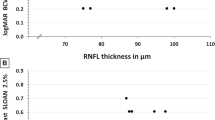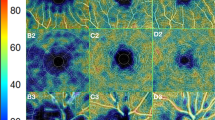Abstract
To study the correlation between the results of frequency-doubling technology perimetry (FDTP), visual function (visual acuity, contrast vision, standard automated perimetry (SAP)) and the thickness of the retinal nerve fiber layer (RNFL) throughout the course of multiple sclerosis (MS). Sixty-six eyes of thirty-three patients suffering from MS were chosen. Thirty-five eyes had a previous history of optic neuritis (ON group) and thirty-one eyes had no previous history of optic neuritis (non-ON group). The FDTP was performed with the N-30 screening program. Visual acuity was determined with the Snellen scale and the ETDRS (Early Treatment Diabetic Retinopathy Study) scale, the contrast vision with the Pelli-Robson and Sloan tests and the SAP with the Humphrey 750 perimeter. The thickness of the RNFL was measured using the STRATUS OCT™ optical coherence tomography (OCT). The visual field FDTP was divided into three sectors corresponding to the three SAP sectors and to the three RNFL quadrants of the OCT. The FDTP was significantly correlated (P < 0.0001) to the contrast vision and to the SAP results (mean deviation (MD) and the different sectors among themselves). In the ON group, the MD FDTP was significantly correlated to the average RNFL thickness (r = 0.44, P = 0.0091). A decrease of 5 decibels (dB) of the MD FDTP corresponded to a decrease of 11.7 μm of the average RNFL thickness (Y = 2.34 × X + 87.5). The strong correlation with SAP and RNFL confirms the value of FDTP in assessing optic nerve damage throughout the course of MS.



Similar content being viewed by others
References
Compston A, Coles A (2002) Multiple sclerosis. Lancet 359:1221–1231
Trobe JD, Beck RW, Moke PS, Cleary PA (1996) Contrast sensitivity and other vision tests in the optic neuritis treatment trial. Am J Ophthalmol 121:547–553
Chauhan BC, Johnson CA (1999) Test-retest variability of frequency-doubling perimetry and conventional perimetry in glaucoma patients and normal subjects. Invest Ophthalmol Vis Sci 40:648–656
Quigley HA (1998) Identification of glaucoma-related visual field abnormality with the screening protocol of frequency doubling technology. Am J Ophthalmol 125:819–829
Polman CH, Reingold SC, Edan G et al (2005) Diagnostic criteria for multiple sclerosis: 2005 revisions to the “McDonald Criteria”. Ann Neurol 58:840–846
Pelli DG, Robson JG, Wilkins AJ (1988) The design of a new letter chart for measuring contrast sensitivity. Clin Vision Sci 1:187–199
Beck RW, Diehl L, Cleary PA (1993) The Optic Neuritis Study Group. The Pelli-Robson Letter Chart: normative data for young adults. Clin Vision Sci 8:207–210
Baier ML, Cutter GR, Rudick RA et al (2005) Low-contrast letter acuity testing captures visual dysfunction in patients with multiple sclerosis. Neurology 64:992–995
Balcer LJ, Baier ML, Cohen JA et al (2003) Contrast letter acuity as a visual component for the Multiple Sclerosis Functional Composite. Neurology 61:1367–1373
Fisher JB, Jacobs DA, Markowitz CE et al (2006) Relation of visual function to retinal nerve fiber layer thickness in multiple sclerosis. Ophthalmology 113:324–332
Sponsel WE, Arango S, Trigo Y, Mensah J (1998) Clinical classification of glaucomatous visual field loss by frequency doubling perimetry. Am J Ophthalmol 125:830–836
Garway-Heath DF, Poinoosawmy D, Fitzke FW, Hitchings RA (2000) Mapping the visual field to the optic disc in normal tension glaucoma eyes. Ophthalmology 107:1809–1815
Cheng H, Laron M, Schiffman J, Tang R, Frishman L (2007) The relationship between visual field and retinal nerve fiber layer measurements in patients with multiple sclerosis. Invest Ophthalmol Vis Sci 48:5798–5805
Trip SA, Schlottmann PG, Jones SJ et al (2005) Retinal nerve fiber layer axonal loss and visual dysfunction in optic neuritis. Ann Neurol 58:383–391
Verriest G, Van Laethem J, Uvijls A (1982) A new assessment of the normal ranges of the Farnsworth-Munsell 100-hue test scores. Am J Ophthalmol 93:635–642
Burnstein Y, Ellish NJ, Magbalon M, Higginbotham EJ (2000) Comparison of frequency doubling perimetry with Humphrey visual field analysis in a glaucoma practice. Am J Ophthalmol 129:328–333
Fujimoto N, Adachi-Usami E (2000) Frequency doubling perimetry in resolved optic neuritis. Invest Ophthalmol Vis Sci 41:2558–2560
Wall M, Johnson CA, Kutzko KE, Nguyen R, Brito C, Keltner JL (1998) Long- and short-term variability of automated perimetry results in patients with optic neuritis and healthy subjects. Arch Ophthalmol 116:53–61
Wall M, Neabring RK, Woodward KR (2002) Sensitivity and specificity of frequency doubling perimetry in neuro-ophthalmic disorders: a comparison with conventional automated perimetry. Invest Ophthalmol Vis Sci 43:1277–1283
Keltner JL, Johnson CA, Spurr JO, Beck RW (1994) Visual field profile of optic neuritis: one-year follow-up in the Optic Neuritis Treatment Trial. Arch Ophthalmol 112:946–953
Sisto D, Trojano M, Vetrugno M, Trabucco T, Iliceto G, Sborgia C (2005) Subclinical visual involvement in multiple sclerosis: a study by MRI, VEPs, frequency-doubling perimetry, standard perimetry, and contrast sensitivity. Invest Ophthalmol Vis Sci 46:1264–1268
Merle H, Olindo S, Donnio A et al (2010) Retinal nerve fiber layer thickness, spatial and temporal contrast sensitivity in multiple sclerosis. Eur J Ophthalmol 20:158–166
Corallo G, Cicinelli S, Papadia M, Bandini F, Uccelli A, Calabria G (2005) Conventional perimetry, short-wavelength automated perimetry, frequency-doubling technology, and visual evoked potentials in the assessment of patients with multiple sclerosis. Eur J Ophthalmol 15:730–738
Kim TW, Zangwill LM, Bowd C, Sample PA, Shah N, Weinreb RN (2007) Retinal nerve fiber layer damage as assessed by optical coherence tomography in eyes with a visual field defect detected by frequency doubling technology perimetry but not by standard automated perimetry. Ophthalmology 114:1053–1057
Nouri-Mahdavi K, Hoffman D, Tannenbaum DP, Law SK, Caprioli J (2004) Identifying early glaucoma with optical coherence tomography. Am J Ophthalmol 137:228–235
Acknowledgments
We would like to thank all the subjects who took part in this study. We also thank Agathe Merle (University of Wisconsin-Madison, Wisconsin), Sarah Meyer (University of Saint-Louis, Missouri), Karen Thérèse (CHU Fort de France), and Eric Ventura (CHU Fort de France).
Conflict of interest
No authors have any financial/conflicting interests to disclose
Author information
Authors and Affiliations
Corresponding author
Rights and permissions
About this article
Cite this article
Merle, H., Olindo, S., Donnio, A. et al. Anatomic and functional correlation of frequency-doubling technology perimetry (FDTP) in multiple sclerosis. Int Ophthalmol 31, 263–270 (2011). https://doi.org/10.1007/s10792-011-9447-7
Received:
Accepted:
Published:
Issue Date:
DOI: https://doi.org/10.1007/s10792-011-9447-7




